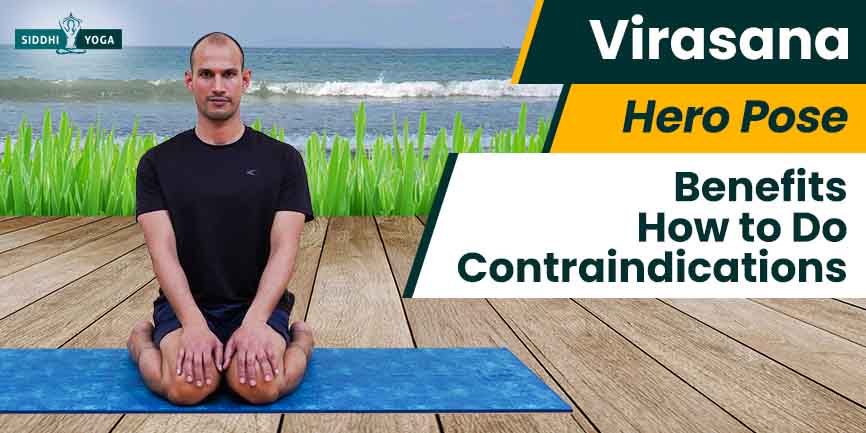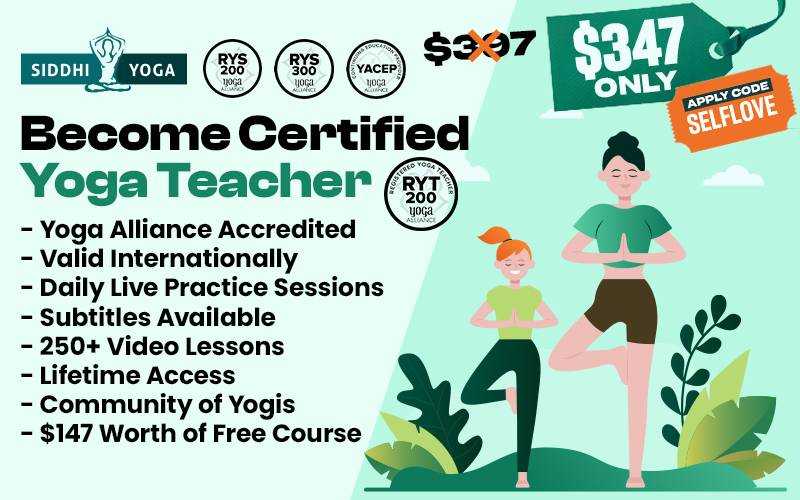
Asana (आसन): means “pose” or “seat”
So, Virasana means “hero pose”
Virasana at a Glance
The “Virasana” yoga pose is a kneeling pose usually used for meditation. It is also called the “Hero Pose” or Reclining Hero Pose, which needs internal hip rotation. The pose is an indication of strength and courage. It is similar to the preparatory pose of “Vajrasana.”
Benefits:
- Helps in the digestion process, improving circulation.
- Provides good flexibility for knees, inner ankles, and lower body.
- Strengthen the hips, thigh muscles, Pelvis, legs, hip flexors, and spine.
- Increases blood circulation and relieves lower back pain.
Who can do it?
People with good flexibility in their knees, hips, and ankles can practice this pose. People who want to grow spiritually can benefit from the hero pose.
Who cannot do it?
People who have severe pain in their knees or have any hip or ankle injuries should avoid the pose.
Introduction
Virasana, or the Hero Pose, is a kneeling pose and is derived from the Sanskrit words “Vira” (hero) and “Asana” (pose). In this pose, the person’s body takes a shape that is associated with the strength and courage of a hero. In Virasana, a person needs to kneel on the floor with buttocks seated between the feet. Knees are closer to each other and feet are wide open.
Chakras
Virasana stimulates the Root Chakra (Muladhara Chakra), Sacral Chakra (Swadhisthana Chakra), and Solar Plexus Chakra (Manipura Chakra).
The pose inculcates feelings of stability and rootedness along with creativity along emotional stability. The pose promotes self-assuredness and enhances inner strength.
Philosophy
Practice Virasana (Hero Pose) to find inner strength to face life’s challenges. The pose also motivates the practitioner to work patiently towards the spiritual journey and thus enhance his spiritual growth. The comfort in the pose helps the practitioner to maintain a steady and strong foundation, thereby balancing sukha and sthira. The meditative aspect of the pose deepens the understanding of the practitioner to align with the principles of yoga philosophy and find stillness and peace within.
How to Do Virasana?
Follow the Step-by-Step Instructions
- Start with kneeling in a comfortable place on the mat. You can roll a blanket or yoga block under your feet or calves for extra support.
- Bring your knees closer and feet wide apart so that your buttocks rest in between the heels. You can also use a yoga block or cushion under your hips as comfortable.
- Keep your spine straight and lift your knees closer to each other.
- Open your chest and place your hands on the thighs. Feel the stretch.
- Keep the alignment perfect by bringing your neck, spine, and head in one straight line.
- Focus on deep and conscious breathing. Hold the pose for a few breaths. Keep your gaze in front. You can practice the pose directly after the meal for good digestion.
- To release the pose, gently lean forward, shifting your weight to your hands. Extend your legs and release tension by slightly shaking them and sit comfortably.
What are the Benefits of Virasana?
- It helps increase the flexibility of thighs and hips by stretching the muscles around the area.
- The pose strengthens the pelvis, legs, hip extension, and spine, which is very useful, especially during pregnancy.
- Since the asana keeps the spine erect, it helps improve the posture.
- Hero Pose aids digestion and helps in relieving the discomfort in abdominal muscles.
- The meditative aspect of the pose helps calm the mind and relax the nervous system. It is often practiced in yin yoga practices.
Health Conditions that Might Benefit from Virasana
- Virasana helps to improve flexibility in the knees.
- The stretching of the knees helps enhance strength around the feet and ankle area.
- Virasana aids in good digestion by stretching the abdominal muscles, thus relieving acidity, bloating, and constipation.
- By relieving tension around the lower back, hips, and legs, it helps in the treatment of sciatica.
- The pose relieves mild backaches since it stretches the lower back muscles.
- The pose relieves stress and anxiety by proper blood circulation throughout the body.
- The pose relieves menstrual cramps and discomfort.
- Virasana helps to treat varicose veins since it increases the blood circulation around this area.
- During pregnancy, Virasana helps relieve tension in the thigh and hip area.
- The pose can relieve tired legs and hips if practiced for a prolonged period.
Safety and Precautions
- People with severe pain in knees and legs may find it uncomfortable due to stretching of knees and ankles.
- People with any chronic pain like arthritis should avoid Virasana.
- People with stiffness in knee joints should either avoid or practice the pose with modification.
- People with severe back pain should avoid the pose.
- For people who have difficulty sitting on the floor, the pose should be modified with the help of props.
- In later stages, pregnant ladies should avoid the pose due to increased pressure on the pelvis and abdomen.
- People with very high blood pressure should avoid the pose.
- People with vertigo should avoid the pose.
- People with any kind of surgery in the hips, legs, or ankles should modify the pose or avoid it.
- People with osteoporosis or brittle bone should avoid the pose.
Virasana and Variations
- Start in Virasana and move backward. This variation provides a deep stretch on the thigh, abdomen, and chest.
- In this variation, you can keep one leg stretched in front and the other leg folded, thus decreasing the intensity of the pose. This is easy for beginners.
- Lift one knee and foot off the ground. This variation deepens the stretch in the thighs and quadriceps.
- You can extend the arms overhead, clasping the hands together and reaching up. This variation stretches the upper body, thus opening the chest and shoulders.
- Supta Virasana: You can try a support for this variation first. You can place your arms to fall on a chair for support. You can lower your back and rest on a support. Draw your pelvis backward to support your back. Then the pose can be tried without support.
- Sandbag assist: This variation can be done with a sandbag to support your lumbar spine.
- You can also combine Virasana and Padmasana.
- From Virasana, extend one leg straight and bend the other, bringing the heels towards the hips. The pose stretches thighs and hips.
- You can modify the pose with props under your sit bones.
Beginner’s Tips
- Always start with a gentle warm-up to stretch your hips, knees, and ankles for the pose.
- Use a folded blanket or yoga blocks to support your sit bones or feet for extra support to avoid injuries.
- Do not keep much tension on the knees. If very uncomfortable, modify the pose with props.
- Beginners can hold the pose for around 30 seconds, then with continuous practice, the duration should be increased.
- Focus on your alignment. Keep your spine straight and chest open. Head, hips, and spine in a straight line. Shoulders should be relaxed. Maintain a steady gaze in front and feet flat on the mat.
- If there is pain while practicing the pose, listen to your body. You can modify the pose as per your flexibility.
- Take slow deep breaths and relax in the pose. Practice regularly to get the optimum results of the pose. With practice, you can go into the deeper variation of the pose.
- Virasana is usually practiced at the beginning or the end of the session as a restorative yoga pose.
Physical Alignment Principles of Virasana
- Start with Dandasana.
- Then, one by one bend your knees and sit on the inner side of your feet in Vajrasana.
- Knees will remain joined together.
- Part your feet hip-width apart so that you can sit comfortably between them.
- Slowly lower your buttocks towards your heels, and sit comfortably between them.
- Rest your hands on your thighs or knees.
- Stay in this position for a few breaths and then slowly come back to the starting position.
Common Mistakes
- Do not rush to get into the pose too quickly. The ground should be comfortable to avoid any ankle injury.
- Hold the pose for a few seconds with deep breathing.
- Keep your gaze in front and align the head, spine and hips straight in one line.
- First, be comfortable in Vajrasana or thunderbolt pose, and then with breathing progress to get Virasana Pose.
Virasana and Breath
While sitting in the kneeling position for the hero pose, the breathing has to be deep and conscious till you are comfortable, then with breathing and relaxing muscles the heels have to be pushed out and the knees closer to each other. The spine must be straight and the shoulders relaxed away from the ears. Focus on proper alignment of the head, spine, and buttocks.
Take Away
Virasana (Hero Pose) provides a deep stretch to thighs, knees, and hips and serves as a preparatory pose for meditations. The pose helps in finding inner peace and stillness thus providing an opportunity for spiritual growth. When practiced regularly mindfulness helps to get greater flexibility and strength, thus providing overall wellbeing of a person. The pose should be practiced slowly for a few seconds for meditation and with practice the duration should be increased to get the maximum benefit.
Are you passionate about yoga and dream of teaching others? Our comprehensive yoga teacher training courses have got you covered! Explore the 200-Hrs Yoga Teacher Training Course, delve deeper into your practice with the 300-Hrs Yoga Teacher Training Course, or master the art of teaching with the 500-Hrs Yoga Teacher Training Course – all certified by Yoga Alliance. Your journey towards becoming a certified yoga instructor begins here. Join us today and let your yoga journey blossom!

Responses